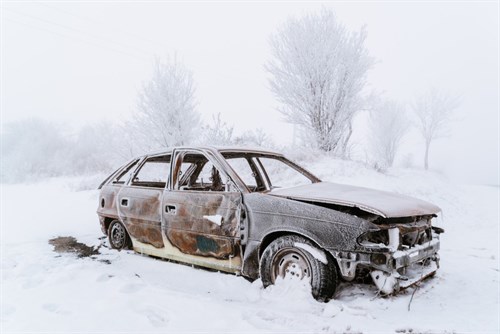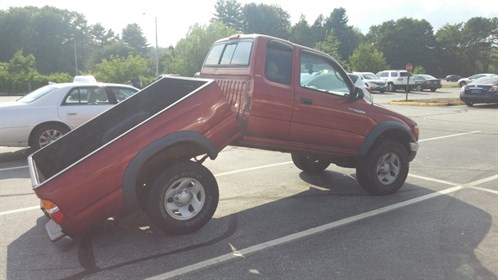
There’s a good reason why mechanics nickname car rust “rot.” Like rot, a serious case of rust will destroy your car over time. Fortunately, rust removal is very possible and affordable … if you take care of it in a timely manner.
Find out how to fix rust on a car, and when it might not be worth it.
Table of Contents
How to Fix Rust on a Car
It’s possible to fix rust spots or repair rust damage on your vehicle, as long as you tackle it quickly and thoroughly. You’ll want to work in a well-ventilated area to avoid inhaling fumes from the primer, paint, and clear coat. Wear safety gear to protect yourself from dust and chemicals, and take your time to ensure each step is done properly for the best results.

If the process to remove rust is too involved or complicated for you, it’s best to take it to a professional auto body shop like Bemac.
Here’s what you’ll need before you start:
- Sandpaper (various grits)
- Wire brush or grinder
- Rust converter
- Primer
- Touch-up paint
- Clear coat
- Masking tape and plastic sheeting
- Safety gear (gloves, goggles, mask)
First, assess the damage. Find out the extent of the rust. Surface rust can often be fixed easily, while deeper rust may require more extensive work or even replacement of affected panels.
Prepare the area. Wash the area with soap and water to remove dirt and grime and dry it thoroughly. Use painter’s tape and plastic sheeting to cover areas around the rust spot to protect them from dust and overspray. You’ll want to be generous with your protection, as the mist from primer or paint can travel quite far.
Remove the rust. Remove the rust using sandpaper (start with a coarse grit and move to a finer grit), a sanding block, or a wire brush. A power sander or grinder can also be used for larger areas. Sand the area until you reach bare metal, ensuring all the rust is removed.
If some rust remains or you want extra protection, apply a rust inhibitor (also known as a rust converter). This will chemically neutralize the rust and prevent it from spreading.
Apply. Once the rust inhibitor is dry (if used), apply an automotive primer to the bare sheet metal. This will help the paint adhere better and provide a protective layer.
If you’re left with a hole in the sheet metal after removing the rust, you’ll need to apply body filler. First apply primer to the area around the hole and let it dry, then fill in the hole using the body primer according to the manufacturer’s instructions. Try to shape it as best as you can to match the body panel, and let it harden completely before continuing.
Once the primer is dry, sand it down lightly with fine-grit sandpaper for a smooth finish.
Paint the area. Apply touch-up paint that matches your car’s paint code. It’s important when doing an automotive paint job to use thin, even coats to avoid drips and achieve a smooth finish, and allow each coat to dry before applying the next one. Multiple thin coats are better than one thick coat.
Apply the clear coat. Once the paint is dry, apply a clear coat to protect the new paint and blend it with the surrounding area. Allow the clear coat to dry completely.
Buff and polish. After the clear coat has dried, use a rubbing compound to buff the area and blend it with the surrounding paint. Follow up with a polishing compound to restore the shine.
Types of Car Rust
Surface Rust
The earliest stage of rust that only affects the top layer of the metal surface. It can develop from minor scratches or paint damage.
What it looks like: Small, reddish-brown spots
Scale Rust
When surface rust is left untreated, it progresses to scale rust. At this stage, the rust penetrates deeper into the metal, which then weakens as it corrodes and flakes off. Scale rust is caused by prolonged exposure to moisture, salt, and neglect of minor rust spots.
What it looks like: Flaking and bubbling paint around the affected areas
Penetrating Rust
This is the most severe form of rust, where the corrosion has eaten through the metal. Penetrating rust compromises the integrity of the car’s body and parts. Long-term neglect of rust treatment, especially in areas exposed to harsh weather conditions and road salts. Penetrating rust often affects the car’s undercarriage, wheel wells, and other areas prone to accumulating moisture and debris.
What it looks like: Holes and structural damage in the body panels or other affected metal parts
Is Car Rust Permanent?
Car rust is not necessarily permanent, but its effects can be long-lasting if not treated properly. The extent to which rust can be removed and the vehicle restored depends on the severity of the rust and how quickly it’s treated.
If you’re not sure if a car is too rusted to fix, bring your car to a trusted body shop for a professional assessment.
Is It Safe To Drive A Car With A Rusted Frame?

A rusted frame will be a major safety hazard if the corrosion is bad enough. Don’t take a chance. Bring your car to a good body shop for the pros to look at. Body shop technicians will put your vehicle up on the lift to inspect it thoroughly from all angles. After assessing structural integrity, they’ll tell you whether an expert welding job could fix the frame or whether you’d be better off just selling the car for scrap.
If you’re shopping for a used car, consider a badly rusted underframe — as opposed to a few minor rust spots on the car body — to be a major red flag. Unless you feel like gambling on a potentially pricey repair (which might cost more than the car itself is worth) and the possibility of failing safety inspection, it’s best to just to move on.
How Long Will A Rusty Car Last?
This is a tough question. It depends on where and how badly the car is rusted, as well as how quickly you get it treated. If you have only a small amount of surface rust and look after the problem promptly, you could still be happily driving your car years from now. However, as mentioned above, a rusty frame is far more serious and might mean the car will have to be junked.
One thing for sure… rust WILL spread to other parts of an automobile when left untreated, and sometimes surprisingly fast. That means what started as a slight problem could develop into a very big deal, sooner than you think.
TIP: Save money and hassle — take proper care of your car and treat any rust spots promptly.
How Much Rust Is Too Much On A Car?
Here’s a question that’s frequently asked before buying a used car. Several considerations are involved:
- Age, mileage, and price. Weigh these factors carefully when forming a decision. Obviously a 15 or 20-year-old car, with 200,000+ kilometres and a bad case of rust, is not a prime candidate for purchase.
- Type of rust. There are 3 types of rust: surface, scale, and penetrating. Surface rust is an easy and affordable fix. Scale rust, exposing the bare metal under the paint, is still repairable, but more difficult. Penetrating rust transforms the car’s steel to iron oxide, turning it brittle and allowing holes to form. This is much more complicated to fix.
- Location of the rust. Corroded supports for the exhaust or fuel tank are clear dangers. Rust on the underframe could negatively impact your ability to drive safely, while rusted body panels might endanger you and your passengers in case of an accident. Penetrating rust in either of these locations can let in water (bad for the vehicle) or exhaust (very, very bad for human beings and pets). Fixing these rust problems might not be worth it.
How To Prevent Rust On A Car?
Keep your car clean and waxed. Washing and waxing your vehicle not only makes it look amazing, but also protects against rust.Wash your car, including the underbody, regularly every two weeks (or as often as once a week in winter, to clean off road salt). Recommended: a professional car wash with clay bar treatment. In addition, apply a coat of wax 2-4 times a year; waxing prior to the first snowfall is especially important when you live in a snowy city like Ottawa.
Catch rust right at the beginning stages. Whenever you rotate your tires – about every 8,000-12,000 kilometres — check your wheel wells and bumpers, prime areas for the onset of rust. Rinse dirt off with a garden hose and inspect the area with a flashlight. Do you see a rust spot or two? Have it taken care of ASAP. And, by the way, did you know that mud flaps do a great job of protecting against water, snow, salt, and gravel (all rust hazards)?
Beware of scratches in paint. If your car’s paint job gets scratched or otherwise damaged, it’s left vulnerable to rust. Fortunately, there’s an easy fix. As long as the scratch doesn’t expose bare metal, a small spot can often be buffed out by an experienced technician. Otherwise, a body repair expert will be needed to sand away the damaged paint and any incipient rust, and then treat in a 4-step procedure: 1) primer, 2) paint, 3) clear coat, and 4) buffing. Now you’re looking good!
Be gentle with your car. Treat your ride right to prevent those nicks and scratches that eventually lead to rust. Remove snow the right way – use a foam brush without stiff bristles. Avoid placing your bag or briefcase on the car even for a minute and be careful never to let your keys scrape the side.
Find Out Whether Fixing Rust On Your Car Is Worth It
Are you wondering whether your car is worth repairing due to rust? You may be pleasantly surprised. Or perhaps you’d just like to do some preventive maintenance.
For professional automobile advice, care, and repair, choose Bemac. We provide high-quality rust repair, rustproofing, car wash service, repainting, and more!
There’s a good reason why mechanics nickname car rust “rot.” Like rot, a serious case of rust will destroy your car over time. Fortunately, fixing rust is very possible and affordable … if you take care of it in a timely manner.
Find out when and if fixing rust on your car is worth it.








